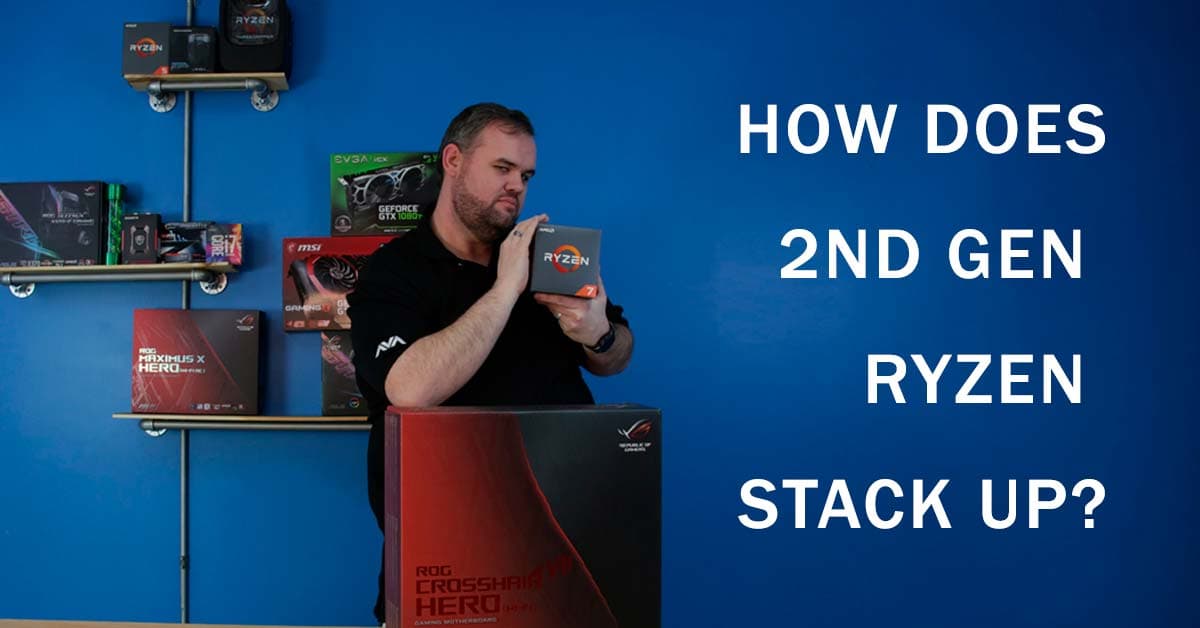
April 26, 2018
|Shannon Kisha2018-04-26T20:36:452023-04-10T12:15:24How Does the New 2nd Gen AMD Ryzen Stack Up?
Category:
Can you believe it's been over a year since AMD released their market changing Ryzen platform? Me either! The good news? They finally released the newest addition to their Ryzen line, their 2000 series processors, codenamed “Pinnacle Ridge”, which will give Intel’s Coffee Lake processors fierce competition. With a new release, means new technology! Let's take a look at what's being offered.
First, let's start with what the new 2nd Gen AMD Ryzen chips look like on paper, as compared to the Ryzen 1000 series chips:
Relatively impressive, right? Overall, you are looking at a 5%-10% performance boost across the board, when it comes to clock speed. This will serve gamers well, as single core speed has taken priority in the new chips, taking advantage of new technologies, such as Precision Boost 2 and Extended Frequency Range 2. We will cover these in more detail a bit later!
Another huge difference between Pinnacle Ridge and Raven Ridge is the lithography. For years, AMD and Intel have both used a 14 nanometer (nm) lithography, and it was time for an upgrade! Luckily, AMD was able to provide that, with their new 12nm lithography. The smaller architecture allows for lower latency, lower power draw, and higher clock speeds! Look for this to be utilized even further in the future!
Now, let's go over the technology AMD is offering:
AMD Ryzen 2 (Pinnacle Ridge)
| Processor | Number of Cores/Threads | Clock Speed: Base/Boost | TDP | Integrated Vega Graphics |
| Ryzen 7 2700X | 8/16 | 3.7/4.35 | 105W | No |
| Ryzen 7 2700 | 8/16 | 3.2/4.1 | 65W | No |
| Ryzen 5 2600X | 6/12 | 3.6/4.25 | 95W | No |
| Ryzen 5 2700 | 6/12 | 3.4/3.9 | 65W | No |
| Ryzen 5 2400G | 4/8 | 3.6/3.9 | 65W | Yes |
| Ryzen 3 2200G | 4/4 | 3.5/3.7 | 65W | Yes |
AMD Ryzen 1 (Raven Ridge)
| Processor | Number of Cores/Threads | Clock Speed: Base/Boost | TDP | Integrated Vega Graphics |
| Ryzen 7 1800X | 8/16 | 3.6/4.0 | 95W | No |
| Ryzen 7 1700X | 8/16 | 3.4/3.8 | 95W | No |
| Ryzen 7 1700 | 8/16 | 3.4/3.7 | 65W | No |
| Ryzen 5 1600X | 6/12 | 3.6/4.0 | 95W | No |
| Ryzen 5 1600 | 4/8 | 3.2/3.6 | 65W | No |
| Ryzen 5 1500X | 4/8 | 3.5/3.7 | 65W | No |
-
Precision Boost 2:
This is one of the largest upgrades for AMD’s new line. Before, their processors used a step function to implement boost speeds. The processor would essentially determine the workload of each core, and attempt to clock said cores to a specific speed, using a predetermined table. The new Precision boost 2 technology attempts to make this process more dynamic, by taking all of the following into account:- Total chip power
- Individual core voltage
- Thermals of each individual core
- Power limitations of each individual core/groups of cores
- Overall thermal limitations and performance
-
XFR2:
-
Neural Net Prediction:
-
Smart Prefetch:
This works in accordance with Neural Net Prediction. The processor will load data that it thinks will be needed, into the cache. This is accomplished with great success in the new Ryzen line, mainly due to increased L3 bandwidth.
Tags:
Latest News

December 29, 2025
|Austin Doherty2025-12-29T05:23:492025-12-29T05:23:49Best Games of 2025
This year is coming to a close. There were quite a few good games that came out this year. The game awards recently happened, and
Read post
December 22, 2025
|Wesley Boyer2025-12-22T07:20:102025-12-22T07:20:10Why Choosing a Pre-Built System is Crucial in 2025/2026
It is no secret that the PC industry is in shambles from short supply and outrageous costs for parts. Custom PC building and gaming used
Read post